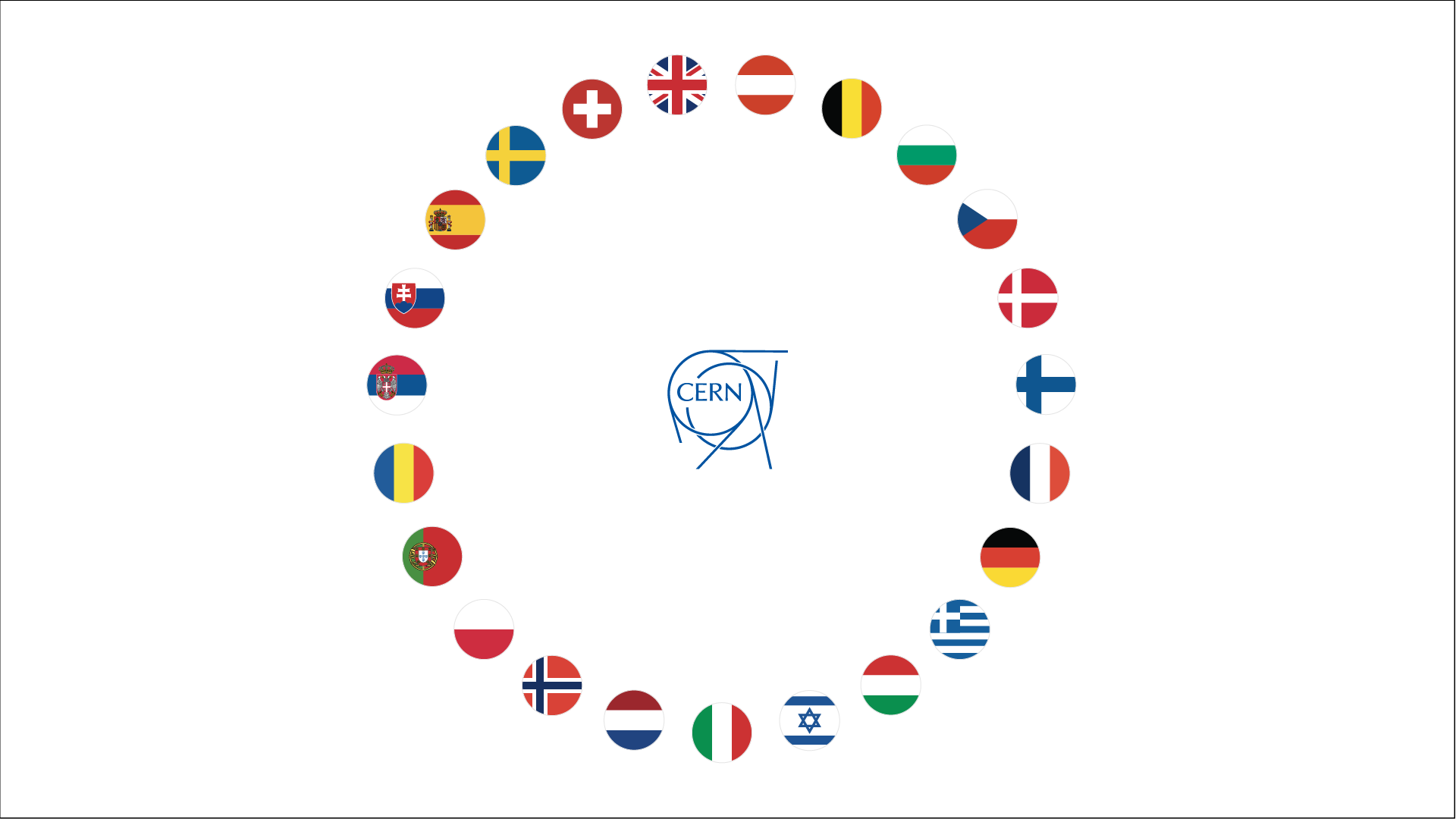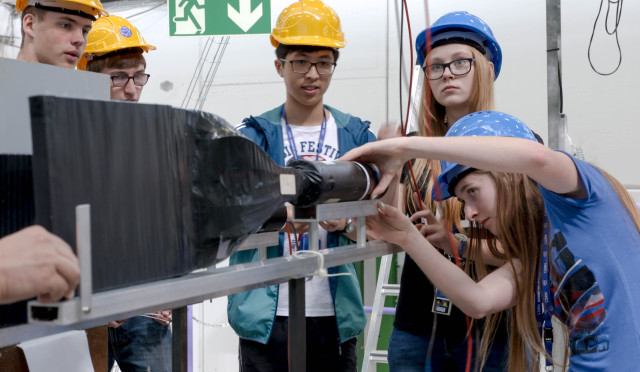What is CERN?
CERN runs the Large Hadron Collider (LHC), the largest particle accelerator in the world. It was founded in 1954 by 12 countries, including the UK, and has now expanded to include 23. The organisation brings together more than 13, 000 researchers from over 75 countries, including 1000 from the UK.

The flags of CERN's 23 member states
CERN's impact on science and technology
CERN's primary research focus is particle physics, but it also runs a much broader science programme, carrying out additional research ranging from nuclear and high-energy physics to studies of antimatter and cosmic rays. It has been responsible for many important scientific discoveries, including:
- Verification of the Standard Model and confirmation of the Higgs Boson (2012), which lead to Peter Higgs and François Englert winning the 2013 Nobel Prize in Physics
- Observation of CP violation in charm quarks (2019)
- Measurement of the number of lepton generations (1990s)
- Discovery of weak neutral currents (1990s)
- Discovery of electroweak (W and Z) gauge bosons (1980s)
Peter Higgs, who first proposed the existence of the Higgs boson in the 1960s
Working at the frontline of physics research, it has always been necessary for CERN to develop technologies to allow it to continue with its scientific work. There are more than 30 examples of these technological innovations, including:
- The World Wide Web, created by Tim-Berners Lee in 1989 to facilitate collaboration between scientists at CERN
- Technology for next-generation radiotherapy, which uses hadron beams instead of X-rays to target and destroy tumours. This causes less damage to healthy tissue and less side effects
- Software tools that are used both in physics and in other areas of research and industry (e.g. the space, nuclear, medicine and aviation sectors)
- Imaging technology now used in medical settings (e.g. current high-performance PET scanners comprise over 20,000 detector elements originally developed for CERN)
- Fibre optic sensors to help manage water shortages and measure water pollution
- Technology for high-radiation environments
From left to right: Robert Cailliau, Nicola Pellow and Tim Berners-Lee, who worked at CERN on the World Wide Web. This photo was taken in March 1993, when the web was first released into the public domain. Photo: CERN
CERN and the UK
The UK contributes 16% of the cost of CERN – about £144m per year, with its subscription being managed by the Science and Technology Facilities Council (STFC). Each member state pays in proportion to their national income.
“The field of particle physics has reached a point where no single country alone can provide the necessary infrastructure and community for the field to flourish. CERN is about the only organisation left in the world that is able to provide the required expertise and facilities.” - quote from survey of UK scientists and engineers
Currently, more than 20 UK universities and research institutes play a role in CERN's research programme, and you can find a full list here. Through these organisations, the UK participates in all four major LHC experiments: ATLAS, CMS, LHCb and ALICE, as well as helping with the general maintenance of the LHC.
How does the UK benefit from CERN?
Aside from CERN's numerous scientific and technological benefits, we also get a lot back from the laboratory. In 2020, independent consultants Technopolis released their report 'Evaluation of the Benefits that the UK has derived from CERN'. This was commissioned by the STFC to evaluate the scientific, economic and social impacts CERN has on the UK and more widely. The following is a short summary, but you can find the full report here.
Business
UK companies won around £183.3m (2018 prices) in contracts from CERN from 2009-2018 to supply the facility with goods and services, and an extra £33.4m in CERN-related scientific endeavours. These businesses also report that working with CERN gives them additional benefits, with 75% of suppliers stating that their reputation and global brand value has improved as a result.
You can see case studies of some of these UK businesses here.
Knowledge and skills
The 1000 UK researchers who work with CERN benefit from the extensive knowledge and skills the working environment provides, as well as more formal training schemes. Researchers who engage with CERN early on in their careers earn on average 12% more throughout their working life.
Between 2008 and 2018, a thousand individuals from the UK participated in CERN training schemes, receiving training (for free) worth more than £4.9m. People trained by CERN often move into other roles within UK companies, taking their skills with them. This benefits the wider economy, particularly in the information technology, advanced technologies and finance sectors.
Science Communication
CERN runs numerous programmes to encourage young people across the world, including in the UK, to pursue science. These include:
About 125 teachers from the UK visit CERN per year to take part in a one week training course - this is more than any other country. A survey of these teachers reported that more than 11, 000 students were taught directly with context from CERN within three months of the visit in physics, maths, biology, chemistry, engineering and computing lessons.
Each year from the UK ~12,000 school students and members of the public visit CERN in person – more than any other country
This scheme worked with the CERN Medipix collaboration, and was given 40 Medipix detectors to use in schools. These were used to support engagement with over 460 schools and 20, 000 students.
IRIS followed on from CERN@School and allows schools and teachers to participate in authentic research, including in space science, particle physics, material science, biomedical science and climate science. A study of a four-year intervention in one school showed that participating A-level students made six times the progress in education attainment compared to a control group of students at the same institution who did not part.
BL4S is a physics competition for high school students from all around the world organised by CERN, the European Laboratory for Particle Physics, in Geneva, Switzerland, and DESY, a German research organisation, in Hamburg. Teams of high school students can propose an experiment that they want to perform at a beamline, that is, a part of a particle accelerator.

Students from the UK and Poland conducting their own experiments at CERN, after winning the third Beamline for Schools competition.
